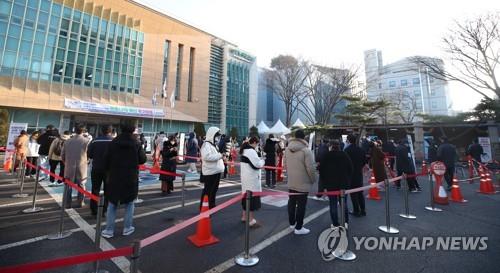- California Assembly OKs highest minimum wage in nation
- S. Korea unveils first graphic cigarette warnings
- US joins with South Korea, Japan in bid to deter North Korea
- LPGA golfer Chun In-gee finally back in action
- S. Korea won’t be top seed in final World Cup qualification round
- US men’s soccer misses 2nd straight Olympics
- US back on track in qualifying with 4-0 win over Guatemala
- High-intensity workout injuries spawn cottage industry
- CDC expands range of Zika mosquitoes into parts of Northeast
- Who knew? ‘The Walking Dead’ is helping families connect
New COVID-19 case spike to over 7,000, critical cases at fresh high
South Korea’s new coronavirus cases spiked to above 7,000 on Wednesday, and the number of critically ill patients surged to a record high.
The country added 7,456 more COVID-19 cases, including 7,365 local infections, bringing the cumulative total to 583,065, the Korea Disease Control and Prevention Agency (KDCA) said.
Wednesday’s tally is sharply up from 5,318 on Monday and 5,202 on Tuesday. The number of new daily cases usually shrinks at the beginning of the week due to less testing over the weekend.
The number of critically ill patients came to a fresh high of 1,063, the authorities said. The previous high was the 1,025 reported Sunday.

People wait in line to get tested for COVID-19 at a makeshift clinic in Seoul on Dec. 22, 2021. (Yonhap)
Health authorities and local governments, meanwhile, had reported 5,308 new cases as of 9 p.m., down 1,141 from the same time the previous day, and 1,256 fewer from the comparable time a week earlier. The capital area accounted for 70.1 percent of new cases tallied at 9 p.m.
Since daily cases are counted until midnight, the figure announced the following morning is expected to be in the 6,000s.
The bed occupancy rate in intensive care units for COVID-19 patients stood at 79.2 percent as of 5 p.m. on Tuesday, slightly down from 80.7 percent from the same time a day earlier. The comparative figure for the wider Seoul area came to 85.7 percent.
A figure higher than 75 percent is considered the saturation point. As of midnight Wednesday, 493 COVID-19 patients in the wider Seoul area were waiting to be admitted to hospitals while undergoing at-home treatment.
Also Wednesday, the government said it will secure some additional 7,000 hospital beds for patients by the end of January to cope with the potential situation of daily COVID-19 cases reaching 10,000.
A total of 6,944 beds will be secured by mobilizing space at state-run and public hospitals across the country.
The government is also planning another set of measures to cope with a possible situation where daily COVID-19 cases reach 15,000.
The country added 78 more deaths from COVID-19, bringing the total to 4,906. The fatality rate stood at 0.84 percent, unchanged from a day earlier.
The country reported seven new omicron variant cases, bringing the total to 234, the authorities said.
On Saturday, the government reimposed a set of revised virus restrictions across the country, which will remain in effect until Jan. 2 to stem the spread of the virus.
It marks a reversal of the government’s “living with COVID-19″ scheme that began last month, with an aim to regain normalcy by relaxing virus restrictions in phased steps.
Under the new measures, the maximum size of private gatherings is limited to four people nationwide, from the previous limit of six in the capital area and eight elsewhere.
A 9 p.m. or 10 p.m. curfew is applied to businesses as well, depending on their type of service.
Of the locally transmitted cases, Seoul reported 2,779 infections and Gyeonggi Province that surrounds the capital logged 2,192 cases.
The KDCA said 91 cases came from overseas, raising the caseload to 16,537.
As of Wednesday, 85.1 percent of the country’s 52 million people had received their first shots of COVID-19 vaccines, and 82.1 percent had been fully vaccinated, while 25.5 percent had gotten booster shots, the KDCA said.











